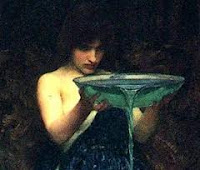Periodically, I have an irresistible urge to re-experience one of my sources of youthful inspiration. I viewed myself as a young man inclined to the visionary approach in a world devoid of mystics. Few people I knew shared my enthusiasm for the world of visions, dreams, mythology, and fantasy. Apart from my older brother, who was probably responsible for nurturing this tendency, I had nobody to speak with about it. It was acceptable, if perhaps a little questionable in terms of taste, to enjoy fantasy literature, but it had to be strictly a momentary escape from reality. Reality was an infinitely superior endeavor, and clearly more worthy of one's time. One's value as a human had to be in some form of measurable production, be that auto parts, haut cuisine, or in published words. If that production could not be converted into dollars and cents, it was valueless. Knowledge or experience was of no relevance if it did not find its way into the pages of a ledger book. Fortunately for both me and my brother, although our parents might not have approved of everywhere it led us, they encouraged us to read and to pursue artistic interests.
Now, as I approach 3 score years, the world has only become more obsessed with materialism. As for myself, now within hitting distance of the aforementioned sixtieth birthday, that materialist view appears even less important than it did at 17. I remained chagrinned but resigned to the fact that I live in a world that values little of that which I see as being of worth.
As a teenager, I explored my own inner world extensively and found it often infinitely better than the external world. That does not mean I was withdrawn, lacking a social life, or otherwise uninvolved in the "real" world, I just was aware of the alternatives. And then it happened.
 There were a lot of other approaches to the inner world that I was exploring at the time, but few had as profound an impact upon me as one did. Ironically, I suspect the author of this particular inspiration thought of it largely as entertainment, albeit entertainment with a message. For the most part, I viewed it the same way. However, the message it held for me was the the visionary explorations I took did not represent something I did in isolation. There were others out there who were familiar with other worlds and were capable of accessing them, too.
There were a lot of other approaches to the inner world that I was exploring at the time, but few had as profound an impact upon me as one did. Ironically, I suspect the author of this particular inspiration thought of it largely as entertainment, albeit entertainment with a message. For the most part, I viewed it the same way. However, the message it held for me was the the visionary explorations I took did not represent something I did in isolation. There were others out there who were familiar with other worlds and were capable of accessing them, too.This particular inspiration came in the guise of the adventures of a profoundly, and at times frustratingly "normal" hero of a tale told in an intentionally anachronistic style. That man was one Jack Flanders, and he had visited another man with the unique name of Meatball Fulton, to share his story. Meatball Fulton, produced and began broadcasting the amazing adventures of Jack Flanders, as old style Radio Dramas, in 1972. The first of these was "The Fourth Tower of Inverness," in which Jack entered an otherwise invisible piece of architecture - the fourth Tower of Inverness Manor, a mansion which in normal reality appeared to have only three towers. In this fourth Tower, he ultimately encounters the Lotus Jukebox, but not in the first story. He does however, need to find the Whirlitzer of Wisdom, the Great Green Jade Jukebox, and the Bodhisattva Jukebox before he can reach the Lotus Jukebox.
His adventures continue later include a trio to North Africa in the Drama entitled "Moon over Morrocco." There have been a number of other Jack Flanders adventures over the years, and several spin-offs for characters such as Mojo Sam, who played a character inspired by a Bogart Movie. However, I did not become aware of these later stories until decades later. For most of my adult life, "Moon over Morrocco" and "The Fourth Tower of Inverness," the first of the Jack Flanders adventure series, which combined elements of Americana and Old-time radio drama with metaphysical concepts such as past life regression, Sufi wisdom, Tibetan Buddhism and shamanistic communication with the natural world, represented the most dramatic parallel to my own inward exploration.
Recently, I noted there was a new Jack Flanders adventure. I admit, I now receive mail order catalogs from ZBS Audio Adventures, the distribution arm of Meatball Fulton's creative nexus. This latest adventure is entitled "Do Angels Really Have WIngs?" It also occurred to me, although I don't recall it in any of the stories I listened to over the years, that there is an uncanny connection between Jack Flanders and Freemasonry. After all, two of his most significant and earliest adventures take place in Scotland and in the Sufi filled world of the North African desert. I wonder when he will meet up with Count Cagliostro.
For the rest of this post, there is not a lot more to comment on. My main thought is to suggest that we can indeed find Hermetic principles in places we hardly expect to, such as in revivalist 1970s Radio Dramas, and perhaps these will inspire us to take some guided flights of fancy, to discover more of our inner world, and what lies beyond the middle chamber.























